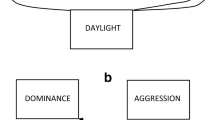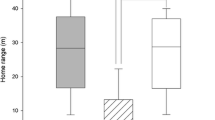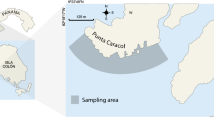Abstract
We examined the impact of dominance on crayfish social spacing and resource control. Spatial distributions of individual crayfish, Orconectes propinquus, were recorded from five sample sites in Douglas Lake, MI, USA. Crayfish populations from each site were collected and then immediately transferred to artificial ponds in order to reproduce potential dominance hierarchies. After 15 h of observation in the artificial ponds, hierarchies were found to stabilize and dominance for each crayfish was scored based on the percentage of total fights an individual won. These dominance scores were then regressed against nearest neighbor distance obtained from field data, crayfish size, and shelter evictions observed during hierarchy formation. Dominant crayfish were found to have greater nearest neighbor distances than lower ranking crayfish. In addition, as the difference in dominance score between nearest neighbors increased, the distance between them also increased. Although claw size was an accurate predictor of dominance, size did not correlate with nearest neighbor distance. Factors such as social dynamics may thus play a larger role in natural crayfish populations than previously thought. Dominant crayfish also performed more shelter evictions during hierarchy formation, which were correlated with nearest neighbor distance, suggesting that eviction by dominant crayfish may enforce spacing. Social status appears to significantly impact crayfish spatial distribution and shelter acquisition such that more dominant crayfish exhibit increased control over space and shelter. Finally, this study suggests the possibility that stable crayfish dominance hierarchies exist in nature.


Similar content being viewed by others
References
Adams ES (2001) Approaches to the study of territory size and shape. Annu Rev Ecol Syst 32:277–303
Alexander RD (1974) The evolution of social behaviour. Annu Rev Ecol Syst 5:325–383
Amano T, Ushiyama K, Fugita G, Higuchi H (2006) Costs and benefits of flocking in foraging white-fronted geese (Anser albifrons): effects of resource depletion. J Zool 269:111–115
Beauchamp G (1998) The effect of group size on mean food intake rate in birds. Biol Rev 73:449–472
Bergman DA, Moore PA (2003) Field observations of intraspecific agonistic behavior of two crayfish species, Orconectes rusticus and Orconectes virilis, in different habitats. Biol Bull 205:26–35
Bovbjerg RV (1970) Ecological isolation and competitive exclusion in two crayfish (Orconectes virilis and Orconectes immunis). Ecology 51:225–236
Chase ID, Tovey C, Spangler-Martin D, Manfredonia M (2002) Individual differences versus social dynamics in the formation of animal dominance hierarchies. Proc Natl Acad Sci 99:5744–5749
Dingle H (1983) Strategies of agonistic behavior in Crustacea. In: Rebach S, Dunham DW (eds) Studies in adaptation: the behavior of higher Crustacea. Wiley, New York, pp 85–111
Drews C (1993) The concept and definition of dominance in animal behaviour. Behaviour 125:283–313
Dugatkin LA (2001) Bystander effects and the structure of dominance hierarchies. Behav Ecol 12:348–352
Edwards DH, Kravitz EA (1997) Serotonin, social status and aggression. Curr Opin Neurobiol 7:812–819
Edwards DH, Issa FA, Herberholz J (2003) The neural basis of dominance hierarchy formation in crayfish. Microsc Res Tech 60:369–376
Fero K, Simon JL, Jourdie V, Moore PA (2007) Consequences of social dominance on crayfish resource use. Behaviour 144:61–82
Garvey JE, Stein RA (1993) Evaluating how chelae size influences the invasion potential of an introduced crayfish. Am Mid Nat 129:172–181
Gherardi F, Cioni A (2004) Agonism and interference competition in freshwater decapods. Behaviour 141:1297–1324
Gherardi F, Daniels WH (2004) Agonism and shelter competition between invasive and indigenous crayfish species. Can J Zool Rev Can Zool 82:1923–1932
Goessmann C, Hemelrijk C, Huber R (2000) The formation and maintenance of crayfish hierarchies: behavioral and self-structuring properties. Behav Ecol Sociobiol 48:418–428
Grant JWA (1993) Whether or not to defend? The influence of resource distribution. Mar Behav Physiol 23:137–153
Haenel GJ, Smith LC, John-Alder HB (2003) Home-range analysis in Sceloporus undulates (eastern fence lizard). I. Spacing patterns and the context of territorial behavior. Copeia 1:99–112
Hall CL, Fedigan LM (1997) Spatial benefits afforded by high rank in white-faced capuchins. Anim Behav 53:1069–1082
Hamilton WD (1971) Geometry for the selfish herd. J Theor Biol 31:295–311
Hamilton IM (2004) Distance to neighbours influences the trade-off between hiding after disturbance and defending food patches in convict cichlids (Archocentrus nigrofasciatus). Behav Ecol Sociobiol 56:530–538
Hazlett BA, Rittschof D, Rubenstein D (1974) Behavioral biology of the crayfish Orconectes virilis. I. Home range. Amer Mid Nat 92:301–319
Hazlett BA, Anderson FE, Esman LA, Stafford C, Munro E (1992) Interspecific behavioral ecology of the crayfish Orconectes rusticus. J Freshw Ecol 7:69–76
Hediger H (1955) Studies of the psychology and behaviour of captive animals in zoos and circuses. Dover, New York
Hemelrijk CK (2000) Towards the integration of social dominance and spatial structure. Anim Behav 59:1035–1048
Hemelrijk CK, Kunz H (2005) Density distribution and size sorting in fish schools: an individual-based model. Behav Ecol 16:178–187
Herrera EA, Macdonald DW (1993) Aggression, dominance, and mating success among capybara males (Hydrochaeris hydrochaeris). Behav Ecol 4:114–119
Hill AM, Lodge DM (1994) Diel changes in resource demand: competition and predation in species replacement among crayfishes. Ecology 75:2118–2126
Hock K, Huber H (2006) Modeling the acquisition of social rank in crayfish: winner and loser effects and self-structuring properties. Behaviour 143:325–346
Hsu YY, Earley RL, Wolf LL (2006) Modulation of aggressive behaviour by fighting experience: mechanisms and contest outcomes. Biol Rev 81:33–74
Issa FA, Adamson DJ, Edwards DH (1999) Dominance hierarchy formation in juvenile crayfish Procambarus clarkii. J Exp Biol 202:3497–3506
Jensen SP, Gray SJ, Hurst JL (2005) Excluding neighbors from territories: effects of habitat structure and resource distribution. Anim Behav 69:785–795
Klocker CA, Strayer DL (2004) Interactions among an invasive crayfish (Orconectes rusticus), a native crayfish (Orconectes limosus), and native bivalves (Sphaeriidae and Unionidae). Northeastern Nat 11:167–178
Maher CR, Lott DF (1995) Definitions of territoriality used in the study of variation in vertebrate spacing systems. Anim Behav 49:1581–1597
Mares MA, Lacher TE Jr, Willig MR, Bitar NA, Adams R, Klinger A, Tazik D (1982) An experimental analysis of social spacing in Tamias striatus. Ecology 63:267–273
Martin AL, Moore PA (2007) Field observations of agonism in the crayfish, Orconectes rusticus: shelter use in a natural environment. Ethology 113:1192–1201 DOI 10.1111/j.1439-0310.2007.01429.x
Moore PA, Bergman DA (2005) The smell of success and failure: the role of intrinsic and extrinsic chemical signals on the social behavior of crayfish. Integ Comp Biol 45:650–657
Noel MV, Grant JWA, Carrigan JG (2005) Effects of competitor-to-resource ratio on aggression and size variation within group of convict cichlids. Anim Behav 69:1157–1163
Pagel M, Dawkins MS (1997) Peck orders and group size in laying hens: ‘future contacts’ for non-aggression. Behav Proc 40:13–25
Parker GA (1974) Assessment strategy and the evolution of fighting behaviour. J Theor Biol 47:223–243
Pavey CR, Fielder DR (1996) The influence of size differential on agonistic behaviour in the freshwater crayfish, Cherax cuspidatus (Decapoda: Parastacidae). J Zool 238:445–457
Poisbleau M, Jenouvrier S, Fritz H (2006) Assessing the reliability of dominance scores for assigning individual ranks in a hierarchy. Anim Behav 72:835–842
Rands SA, Pettifor RA, Rowcliffe JM, Cowlishaw G (2006) Social foraging and dominance relationships: the effects of socially mediated interference. Behav Ecol Sociobiol 60:572–581
Ranta E, Lindstrom K (1992) Power to hold sheltering burrows by juveniles of signal crayfish, Pasifasticus leniusculus. Ethology 92:217–226
Robinson CA, Thom TJ, Lucas MC (2000) Ranging behaviour of a large freshwater invertebrate, the white-clawed crayfish Austropotamobius pallipes. Freshw Biol 44:509–521
Statzner B, Fievet E, Champagne JY, Morel R, Herouin E (2000) Crayfish as geomorphic agents and ecosystem engineers: biological behavior affects sand and gravel erosion in experimental streams. Limnol. Oceanogr 45:1030–1040
Treisman M (1975) Predation and the evolution of gregariousness. I. Models for concealment and evasion. Anim Behav 23:779–800
Webster MM, Hart PJ (2006) Subhabitat by foraging threespine stickleback (Gasterosteus aculeatus): previous experience and social conformity. Behav Ecol Sociobiol 60:77–86
Weir LK, Grant JWA (2004) The causes of resource monopolization: interaction between resource dispersion and mode of competition. Ethology 110:63–74
Acknowledgements
The authors wish to thank the following people for their contributions to this manuscript: Jennifer Bergner, Arthur Martin, Jodie Simon, and Tom Zulandt for assistance with crayfish field sampling, as well as the University of Michigan Biological Station and Bob Vande Kopple (UMBS) for providing bathymetric maps with marked study site locations. We thank the Laboratory for Sensory Ecology, Dr. Marcus Chibucos, and the anonymous reviewers for their helpful comments on this manuscript. This research was generously funded by the Crustacean Society Graduate Research Fellowship to K.F. and the National Science Foundation (IBN #0131320) grant to Paul A. Moore. This research is in compliance with current laws of the USA.
Author information
Authors and Affiliations
Corresponding author
Additional information
Communicated by P. Backwell
Rights and permissions
About this article
Cite this article
Fero, K., Moore, P.A. Social spacing of crayfish in natural habitats: what role does dominance play?. Behav Ecol Sociobiol 62, 1119–1125 (2008). https://doi.org/10.1007/s00265-007-0540-x
Received:
Revised:
Accepted:
Published:
Issue Date:
DOI: https://doi.org/10.1007/s00265-007-0540-x




